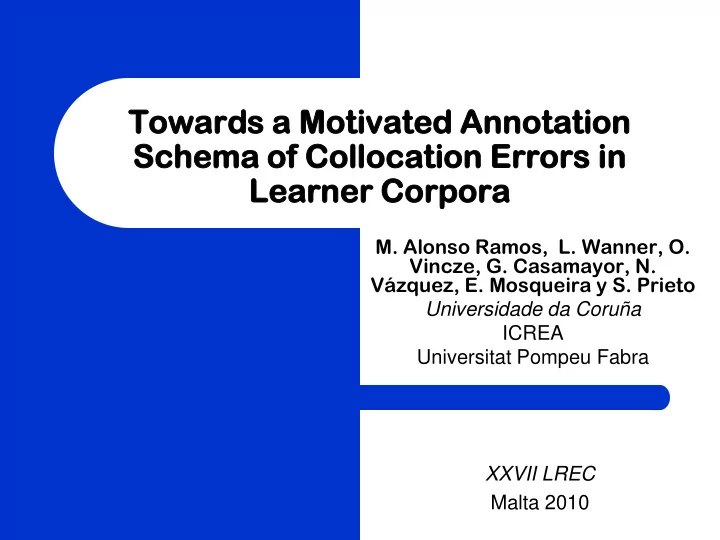

Towar ards a s a Motivat vated A Annotat ation Sc Schema of of Col olloc ocation on Er Error ors i in n Learne ner C Corpor ora M. Alonso Ramos, L. Wanner, O. Vincze, G. Casamayor, N. Vázquez, E. Mosqueira y S. Prieto Universidade da Coruña ICREA Universitat Pompeu Fabra XXVII LREC Malta 2010
The Problem ● The relevance of collocations (in the sense of Hausmann, Mel’ č uk et al.) in L2 learning is generally acknowledged dar un paseo / faire une promenade ‘[to] take a walk ’ fumador empedernido / gros fumeur ‘ heavy smoker ’ ● It is collocations which are difficult to master by the learners! Typical errors: hacer un paseo / donner une promenade ‘ [ to ] take a walk big smoker/ lourd fumeur ‘ heavy smoker ’ ● Current learner error annotation schemata tend to group collocation errors into one single subclass of lexical errors BUT
The Problem ● A look at a learner corpus of Spanish (CEDEL2) http://www.uam.es/proyectosinv/woslac/cedel2.htm shows that collocation errors of rather different types can be identified salvar dinero ‘to save money’ (instead of ahorrar dinero ) recibir un llamo ‘to receive a call’ (instead of recibir una llamada ) asistir la universidad , lit. ‘to attend university’ (instead of asistir a la universidad ) … ● A more detailed collocation error classification is needed!
Outline 1. Towards a typology of collocation errors (based on a Spanish learner corpus) 2. Knowtator: Tool for annotating collocation errors in the corpus 3. The framework of our work:The research project COLOCATE 3.1. Creation of collocation-oriented content in a web-based learning environment 3.2. Automatic processing of collocations in a web-based learning environment 4. Preliminary findings 5. Conclusions and future work
1. Three-dimensional Collocation Error Typology: (i) location (ii) descriptive (iii) explanatory
1. Location dimension
2. Descriptive dimension
3. Explanatory Dimension
Ilustration of interlingual lexical errors ( affecting the base or the collocate )
Ilustration of interlingual lexical errors ( affecting the base or the collocate)
Ilustration of interlingual and intralingual grammatical errors ( affecting the base or the collocate)
2. The corpus annotation tool: Knowtator
The annotation schema in knowtator
Tagging collocations with knowtator
3. The research project: towards a Learning Environment COLOCATE
The Objectives of COLOCATE A) Develop didactic means which support 1) interactive learning with collocation error verification and NLP-based error correction 2) data-driven active learning B ) Develop resources such as 1) DiCE Diccionario de colocaciones del español (DiCE) http//www.dicesp.com 2) personalized collocation dictionaries 3) collocation-annotated learner corpus C ) Develop NLP-techniques 1) For automatic recognition and classification of collocations 2) For automatic error correction and learning material provision
4. Preliminary Findings
Preliminary findings
5. Conclusions and Future Work
5. Conclusions 1) Collocation errors in learner corpora are far from homogeneous and neither is their distribution! 2) A fine-grained collocation error typology is needed to capture the major error types 3) Targeted exercises and targeted supplementary teaching material (provided by automatic means) are needed to support active language learning 4) COLOCATE is about to address the important issues in L2 learning: (i) adequate didactic tools, (ii) collocation and collocation error resources; (iii) NLP techniques for tracing and classification of collocations and collocation errors
5. Future Work Continue with the annotation of the learner corpus with collocation errors Continue with the annotation of the learner corpus with collocations (Lexical Functions) Extend the DICE Provide resources for didactic material Continue to work on ML-based recognition/ classification of collocations and collocation errors Etc., etc., etc.
Thank you very much for your attention!
Recommend
More recommend